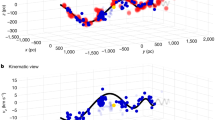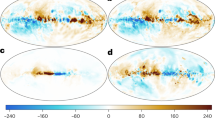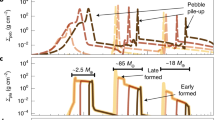Abstract
The precise nature of the rings of Saturn is poorly understood. There is controversy, for example, over whether the rings have relaxed into essentially a monolayer, or whether the observed sharp brightening near opposition confirms the classical model of mutual shadowing in a layer many particles thick1–3. Likewise, the observations of azimuthal brightness variations in the rings (variations as a function of orbital phase of the ring particles)4–6 have been interpreted as implying the presence of large, synchronously rotating particles with either elongated shapes or systematic leading–trailing–edge albedo differences7 (although such synchronous rotation seems very unlikely)8; or alternatively the presence of density waves analogous to those postulated for spiral galaxies9 or ‘density wakes’ resulting from mutual gravitation between a relatively large ring particle and nearby smaller particles. Here we present a model to explain azimuthal brightness variations in the rings. Assuming the existence of density irregularities as a result of self-gravitation, we outline the probable photomeric effects. The results amplify the purely geometric discussion given by Franklin and Colombo10.
This is a preview of subscription content, access via your institution
Access options
Subscribe to this journal
Receive 51 print issues and online access
$199.00 per year
only $3.90 per issue
Buy this article
- Purchase on Springer Link
- Instant access to full article PDF
Prices may be subject to local taxes which are calculated during checkout
Similar content being viewed by others
References
Pollack, J. B. Space Sci. Rev. 18, 3–94 (1975).
Cuzzi, J. N. & Pollack, J. B. Icarus 33, 233–262 (1978).
Esposito, L. W. & Lumme, K. Icarus 31, 157–167 (1976).
Lumme, K. & Irvine, W. M. Astrophys. J. Lett. 204, L55–L57 (1976).
Reitsema, H. J., Beebe, R. F. & Smith, B. A. Astr. J. 81, 209–215 (1976).
Ferrin, I. R. Astrophys. Space Sci. 33, 453–457 (1975).
Lumme, K. & Irvine, W.M. Astr. J. 81, 865–893 (1976).
Peale, S. J. in Natural Satellites (ed. Burns, J.) 87–112 (University of Arizona Press, Tucson,1977).
Colombo, G., Goldreich, P. & Harris, A. Nature 264, 344–345 (1976).
Franklin, F. A. & Colombo, G. Icarus 33, 279–287 (1978).
Lumme, K., Esposito, L. W., Irvine, W. M. & Baum, W. A. Astrophys. J. Lett. 216, L123–L126 (1977).
Lumme, K., Irvine, W. M., Martin, L. J. & Baum, W. A. Astrophys. J. Lett. 229, L109–L111 (1979).
Sobolev, V. V. Light Scattering in Planetary Atmospheres, ch. 9 (Pergamon, Oxford, 1975).
Kawata, Y. & Irvine, W. M. Icarus 24, 472–482 (1975).
Lebofsky, L. A., Johnson, T. V. & McCord, T. B. Icarus 13, 226–230 (1970).
Irvine, W. M. & Lane, A. P. Icarus 18, 171–176 (1973).
Lumme, K., Thompson, W., Irvine, W. M., Martin, L. J. & Baum, W. A. Bull. Am. astr. Soc. (in the press).
Author information
Authors and Affiliations
Rights and permissions
About this article
Cite this article
Lumme, K., Irvine, W. A model for the azimuthal brightness variations in Saturn's rings. Nature 282, 695–696 (1979). https://doi.org/10.1038/282695a0
Received:
Accepted:
Issue Date:
DOI: https://doi.org/10.1038/282695a0
This article is cited by
-
The wake model for azimuthal brightness variations in Saturn's A-ring
The Moon and the Planets (1983)
Comments
By submitting a comment you agree to abide by our Terms and Community Guidelines. If you find something abusive or that does not comply with our terms or guidelines please flag it as inappropriate.



